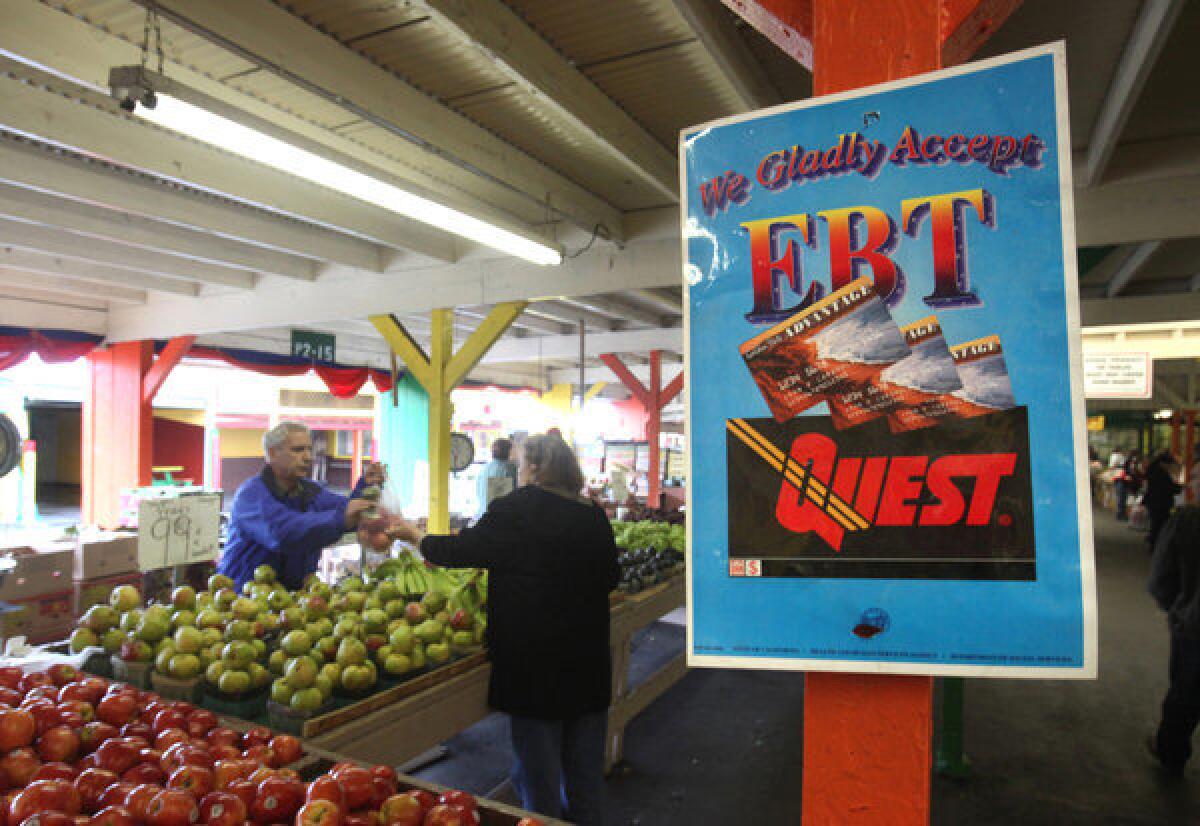Demand for food stamps surges in California as virus takes economic toll

- Share via
SACRAMENTO — With many Californians losing income and jobs, the economic toll of the coronavirus pandemic has spurred a record surge in the number of applications for CalFresh, the state’s food stamp program, forcing operational changes to expedite help for those unable to put meals on the table.
The number of people applying for food assistance jumped to 55,624 in the third week of March, up from 34,882 during the same period last year, said Jason Montiel, a spokesman for the state Department of Social Services.
In Los Angeles County, CalFresh applicants nearly doubled from 9,060 in the third week of March 2019 to 17,532 during the same period this month.
“This is higher than anything we have ever seen,“ said Tracey Patterson, senior director with Code for America, a nonprofit that partners with the state to sign people up for CalFresh.
Her group has seen a 350% increase in the number of people applying online at GetCalFresh.org with help from Code for America since the COVID-19 crisis began.
“Right now we are seeing a lot of folks who have never applied for anything before — folks who are bartenders, hairstylists, folks who make decent money but still live paycheck to paycheck,” Patterson said. “And when that evaporates, they don’t have savings.”
Holly Diaz has seen her hours at a Burger King in Sacramento cut from 40 to 30 per week because fewer people are patronizing the restaurant. Diaz, who has a 4-year-old child, said her husband was out of work.
“We are struggling to get by. We’ve been out of food for three days,” Diaz, 42, said tearfully. Her family is anticipating a temporary supplemental boost to their CalFresh benefit thanks to congressional action in response to the pandemic.
CalFresh is California’s version of the federal Supplemental Nutrition Assistance Program, or SNAP, which provides $16 to $194 in federally funded benefits per month to low-income residents, older people and those on Supplemental Security Income, depending on their level of need.
The program, administered by California counties, served more than 4 million people statewide as of January, providing them with monthly benefits on an electronic benefit transfer card that can be used to buy most foods at many markets and food stores.
“CalFresh food benefits not only allow households to meet their nutrition needs and prevent food insecurity,” Montiel said, “but they also allow households to use other limited financial resources on basic needs, such as housing,”
On Tuesday, the administration of Gov. Gavin Newsom sent $24 million to counties to help pay for the increased CalFresh workload.
Newsom also issued an executive order earlier this month to ease rules for those applying for a host of social service programs, including CalFresh, Medi-Cal health coverage, welfare assistance through CalWorks and in-home support services. The order suspends a requirement that the state periodically determine whether recipients remain eligible.
“These social safety net programs are so important for families — especially during this crisis,” Newsom said. “We don’t want Californians who rely on these services to lose them.”
The state has also asked federal officials to waive a rule that prohibits CalFresh recipients from purchasing food online for delivery, pointing out that forcing people into stores potentially exposes them to the virus and runs counter to Newsom’s statewide stay-at-home order.
Pilot programs have operated in other parts of the country, but California has not yet heard back on its request.
The ability to buy food online with CalFresh has been pushed for years by Jessica Bartholow, legislative advocate for the Western Center on Law and Poverty.
“Now that we are in [the] COVID-19 [pandemic], there is an undeniable urgency to expedite the ability of the state to be able to do this,” Bartholow said.
The federal government has also made changes to assist applicants for food stamps. In the past, a major obstacle to getting food assistance has been the requirement for applicants to first undergo a phone interview.
Applicants often had to wait months for an interview; as a result, people fell out of the process, said Patterson, whose group has an outreach contract with the state in order to partner with all the counties on CalFresh enrollment.
In the face of the public health crisis, the U.S. Department of Agriculture has provided a short-term waiver for the interview before benefits can be provided. Interviews will still be held later.
Patterson said an applicant told her he normally would check dumpsters for leftover food, but many restaurants have shut down and he‘s concerned about risking exposure to the coronavirus.
Code for America, which was created to help people use digital means to get government services, would also like to see CalFresh increase its benefits, arguing $16 per month is not sufficient.
The group has also called on state and federal officials to remove other verification requirements for new applicants, reduce the time for processing applications and provide money for technical support to agencies that have closed offices and overburdened call centers.
Making sure the program works efficiently is important at a time when many people are seeing jobs or income evaporate on a moment’s notice, according to Scott Gerber, a spokesman for Code For America.
“The whole system is just flashing red that people are in trouble,” Gerber said. “They need help. They need assistance quickly.”
More to Read
Sign up for Essential California
The most important California stories and recommendations in your inbox every morning.
You may occasionally receive promotional content from the Los Angeles Times.














